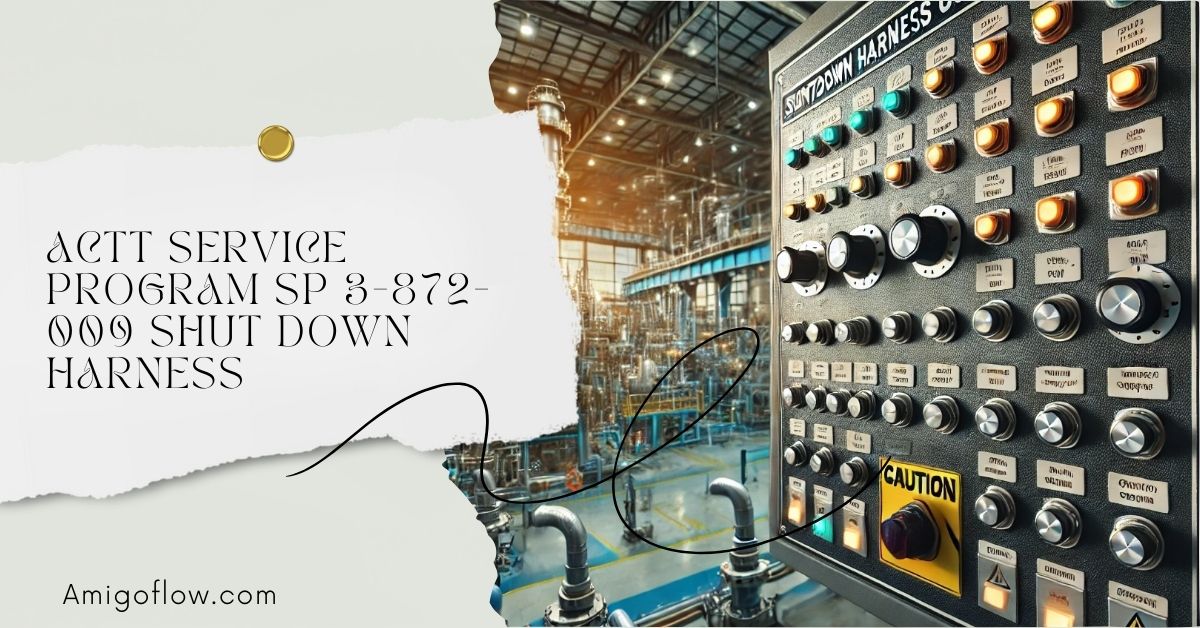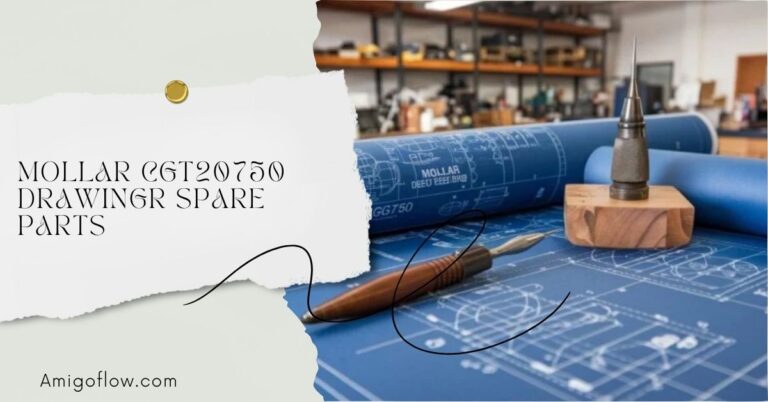When it comes to industrial machinery, safety is the highest priority. The risks involved in running heavy equipment can be high, especially in industries like manufacturing, construction, and energy.
Unplanned breakdowns or equipment malfunctions can cause serious damage, not only to the machinery itself but also to workers nearby. That’s where safety systems like the ACTT Service Program SP 3-872-009 Shut Down Harness come in.
This specialized safety device is designed to prevent accidents by automatically shutting down machinery in the event of a malfunction. In this article, we’ll cover everything you need to know about the ACTT Service Program SP 3-872-009 Shut Down Harness.
What is the ACTT Service Program SP 3-872-009 Shut Down Harness?
The ACTT Service Program SP 3-872-009 Shut Down Harness is a safety mechanism designed to automatically shut down machinery during critical failures or unexpected malfunctions. It is used in a wide range of industrial settings, including manufacturing plants, construction sites, and power generation facilities. The device’s primary function is to detect system anomalies, such as overheating, overloading, or other mechanical faults, and initiate a controlled shutdown of the equipment.
The automatic shutoff feature ensures that equipment damage and safety hazards are minimized, protecting both the machinery and the people working around it. The system is robust, reliable, and designed to react within seconds of detecting an issue.
How Does the ACTT Service Program SP 3-872-009 Shut Down Harness Work?
The shut down harness operates through a system of sensors and controllers that continuously monitor the equipment’s performance. Here’s a step-by-step breakdown of how it works:
1. Monitoring Critical Parameters
The harness is designed to monitor various critical parameters within the equipment, such as temperature, pressure, electrical load, and mechanical strain. These parameters help the system determine if the machine is operating within safe limits.
2. Detecting Faults or Anomalies
When the system detects a fault, such as overheating or excessive load, the harness immediately identifies it as a potential risk. This anomaly could be due to a malfunctioning component, an external factor, or any unforeseen circumstance that could compromise the safety of the operation.
3. Initiating a Controlled Shutdown
Upon detecting a fault, the harness triggers a controlled shutdown of the machinery. This shutdown is carefully managed to ensure that no further damage occurs during the process. For instance, the system may gradually lower power to the machine or disengage critical components to avoid sudden stops that could lead to accidents.
4. Preventing Equipment Damage and Accidents
By shutting down the equipment before a serious failure occurs, the harness prevents both damage to the machinery and potential injury to workers. This proactive approach helps extend the lifespan of the equipment while maintaining the highest levels of safety.
Benefits of Using the ACTT Service Program SP 3-872-009 Shut Down Harness
Implementing the ACTT Service Program SP 3-872-009 Shut Down Harness can offer a variety of benefits for industries that rely on heavy equipment. Here are some of the most significant advantages:
1. Enhanced Safety
The primary benefit of the shut down harness is improved safety. It ensures that machinery is automatically shut down when necessary, minimizing the risk of accidents that could harm workers.
2. Prevents Equipment Damage
By detecting faults early and shutting down machinery before critical failures, the harness prevents expensive repairs and reduces downtime due to equipment breakdowns. This not only saves money but also keeps production running smoothly.
3. Increased Operational Efficiency
Because the system is automated, there’s no need for manual monitoring of every critical parameter. This means that workers can focus on their primary tasks while the harness keeps an eye on the machinery. This leads to greater operational efficiency and productivity.
4. Compliance with Safety Regulations
Many industries are required by law to follow strict safety guidelines. Installing the ACTT Service Program SP 3-872-009 Shut Down Harness can help companies comply with regulations set by organizations like the Occupational Safety and Health Administration (OSHA) in the U.S. Failure to comply with these regulations can result in heavy fines and legal consequences.
Key Features of the ACTT Service Program SP 3-872-009 Shut Down Harness
The ACTT shut down harness comes with a set of features that make it one of the most effective safety solutions for industrial machinery. Some of the key features include:
1. Real-Time Monitoring
The harness continuously monitors the machinery in real time, ensuring that any anomalies are detected immediately.
2. Automated Response
As soon as a fault is detected, the system triggers an automatic shutdown, eliminating the need for human intervention.
3. Customizable Settings
The harness can be customized to monitor specific parameters that are most relevant to the type of machinery it is installed on. This allows companies to tailor the system to their unique operational needs.
4. Durable Construction
The harness is built to withstand harsh industrial environments. It is designed to be resistant to heat, chemicals, moisture, and physical wear, making it a reliable long-term solution.
5. Failsafe Mechanism
In the event of a system failure within the harness itself, the failsafe mechanism ensures that the machinery is still safely shut down to prevent any accidents or equipment damage.
Industries That Benefit from the ACTT Service Program SP 3-872-009 Shut Down Harness
The ACTT Service Program SP 3-872-009 Shut Down Harness is versatile and used in a wide variety of industries, each benefiting from the protection it provides. Some of the most common industries where the harness is used include:
1. Manufacturing
In the manufacturing sector, equipment often runs continuously and under extreme conditions. The shut down harness helps ensure that machinery doesn’t overheat or suffer mechanical failures, which could result in downtime or production delays.
2. Construction
Construction sites are often high-risk environments with heavy machinery that must be monitored closely. The harness provides an extra layer of safety by shutting down equipment during critical failures, preventing accidents and reducing liability.
3. Energy
In the energy sector, particularly in power generation and oil and gas operations, any malfunction can lead to severe consequences. The harness helps monitor critical machinery, reducing the risk of catastrophic failures.
4. Mining
The harsh conditions in mining operations, combined with the heavy loads placed on equipment, make the shut down harness a vital safety feature. It ensures that machinery is shut down safely when necessary, preventing both equipment damage and worker injury.
Installing and Maintaining the ACTT Service Program SP 3-872-009 Shut Down Harness
Installing the ACTT shut down harness requires careful planning and expertise. Here’s a general overview of the steps involved in installation and maintenance:
1. Installation
- Assessment of Machinery: Before installation, an assessment of the machinery is conducted to determine the appropriate configuration for the shut down harness.
- Wiring and Integration: The harness must be properly wired to the equipment and integrated with the machine’s control systems.
- Testing: After installation, the system is tested to ensure that it functions correctly and detects potential faults.
2. Regular Maintenance
- Routine Inspections: Regular inspections should be carried out to ensure that the sensors and control systems are working as intended.
- Software Updates: In some cases, the harness may require software updates to maintain optimal performance.
- Component Replacements: Over time, certain components of the harness, such as sensors or wiring, may need to be replaced due to wear and tear.
Proper maintenance of the shut down harness is essential to ensure that it continues to function effectively and provide the highest level of safety.
Frequently Asked Questions (FAQs)
A: The shut down harness is compatible with a wide range of machinery, including manufacturing equipment, construction machinery, energy-sector devices, and more. It can be customized to suit different operational needs.
A: The harness uses a series of sensors to monitor critical parameters like temperature, pressure, and electrical load. When an abnormality is detected, the system triggers an automatic shutdown to prevent damage or accidents.
A: Installation should be carried out by a professional who understands the specific machinery. The process includes wiring, integrating the system with the control mechanisms, and testing to ensure proper functionality.
A: Regular maintenance should be conducted based on the manufacturer’s recommendations. Routine inspections, software updates, and component replacements ensure the system operates at peak efficiency.
A: While the shut down harness is designed to prevent many types of failures, it cannot cover every possible issue. However, it significantly reduces the risk of major equipment damage and safety hazards.
Conclusion
The ACTT Service Program SP 3-872-009 Shut Down Harness is an essential safety feature for industries that rely on heavy machinery. By monitoring equipment in real-time, detecting faults, and initiating automatic shutdowns, the harness helps to prevent accidents, reduce equipment damage, and ensure operational efficiency. Its ability to improve workplace safety and comply with regulatory standards makes it a valuable investment for companies across multiple sectors.















